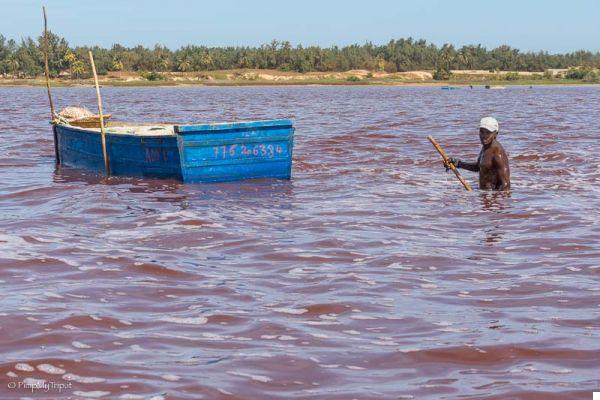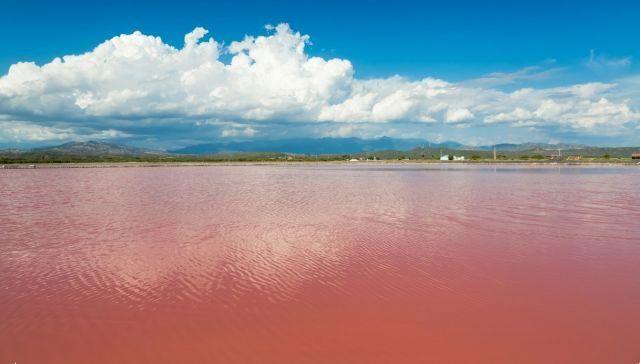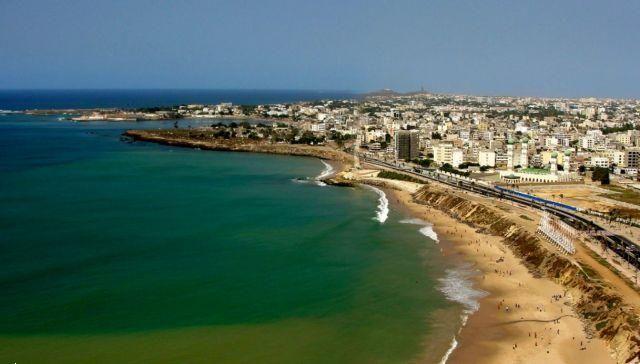Only a short ferry ride separates the small Ile de Gorée, Gorée Island, from the capital of Senegal, Dakar Rally. The popularity of this small island is mainly linked to its history which tells of the trade in slaves from 1444 to 1848 across the Atlantic to America, Brazil and the Caribbean.
The entire island was included in the UNESCO World Heritage List in 1978. The very famous Maison des Esclaves has been a museum since 1962.
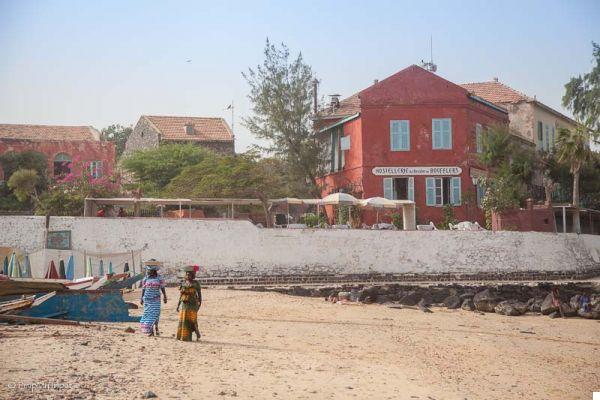
The tranquility today on the island of Gorée stands in stark contrast to its terrible history
Today the beauty of the island of Gorée stands in stark contrast to its horrific history. The sandy beaches are quiet and pristine, the streets lined with flower beds, the quaint little houses are lined with bougainvillea, restaurants and boutiques pop up everywhere.
Gorée offers a glimpse of life in a colonial settlement built to support the slavery industry. Visitors can step back in time as little has changed on the island.
ENGLISH TOUR OF THE ISLAND OF GOREE - Update 2019
State offre this tour in English with hotel pickup (in Dakar), transport by ferry and guide.
The homes of wealthy slave traders have remained the same as they were during the 1700s.
- History of Gorée
- The slave trade
- What to see on the island of Gorée
- The House of Slaves
- IFAN Historical Museum
- Castle and Cannon
- Other things to see
- How to get to Gorée
History of the island of Gorée
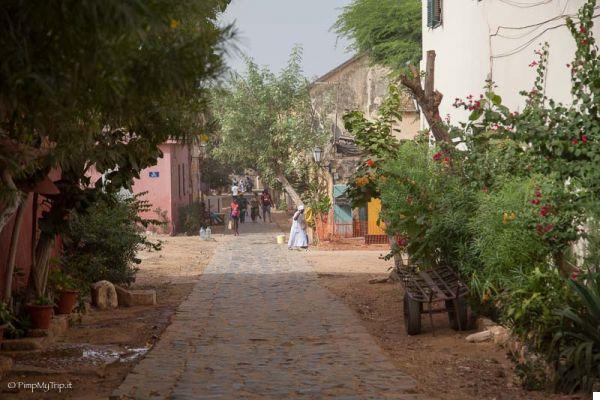
THEGorée Island owes its existence to a large volcanic rock (basalt) which constitutes the part that is called the Castel or the highest part of the island.
This massif was a fragment of a volcanic flow that formed about 13.000.000 years ago.
Subsequently the sea, year after year, subjected the volcanic flow to a great erosion that separated it from the rest of the continent, making the volcanic massif an isolated peak, and at the same time creating the sandy deposits that today make up the lower part of the island.
During the Neolithic period the populations (mostly fishermen and goat farmers) began to move here from the coast: the various basalt finds found on the island testify to this, which have been dated to about 4.000 years ago.
From the Iron Age onwards, the inhabitants of the continent continued to move to the island by importing the famous goats mentioned in their writings by the first sailors who landed here.
I Portuguese they were the first to arrive on the island of Gorée in 1444 and in 1481 they built the first chapel, but did not settle here.
The island which then bore the name of Bir was renamed Palma Island.
Later, during the 16th century, the French and English used the island of Gorée as a base for visiting the Ivory Coast: here they reformed and loaded stones to be used as ballast for their boats.
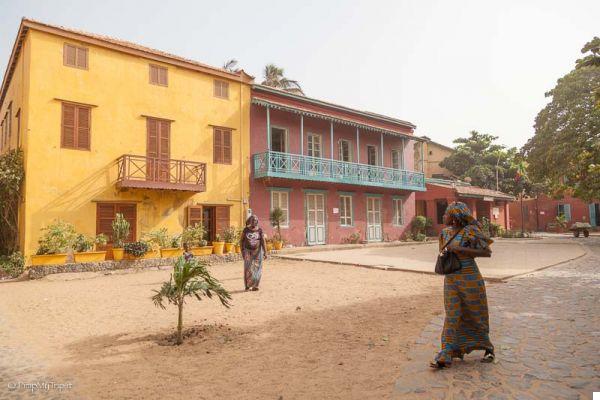
The colonial houses of Gorée were once used both as homes for traders and as "warehouses" for human goods.
The first Europeans to settle more or less definitively on the island were the Dutch who gave it to Gorée the name it still bears today and to whom in 1627 the island was offered to him as a gift by King Biram.
La Dutch West Indies company he built, in 1628 on the lower part of the island, the first fortified settlement and in the upper part he built a fort.
Until the abolition of the slave trade by the English in 1807, the island of Gorée had the role of "warehouse" for slaves.
After that the island experienced a flourishing period of commercial activity and after the mid-19th century it had more than 5.000 inhabitants.
In 1817 the French took possession of the island and remained their property untilindependence of Senegal in 1960.
Abandoned after the foundation and the boom of the city of Dakar, in 1931, the island of Gorée had about 600 inhabitants, and today it has almost a thousand.
The slave trade
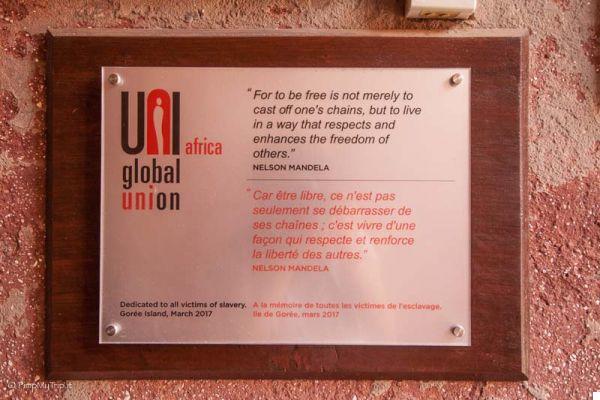
Commemorative plaque commemorating Gorée's past inside the House of Slaves
THEhistorical importance of the island of Gorée it is due to the fact that this small island is believed to have played a major role as a trading port in the slave trade on the transatlantic trade.
The slave trade was aimed at transporting the peoples of West Africa to the Americas to bring laborers to the plantations.
Before the Europeans set foot on the soil of that region which was then called Senegambia (now known as Senegal and Gambia, the smallest country within the borders of Senegal) slavery already existed on the continent.
A legend tells that a king of the empire of Mali, Mansa Musa, had so much gold that during his religious pilgrimage to Mecca he brought thousands of men as slaves to carry his gold bars and to build cities for him and his entourage as they stopped along the way.
Of course, not that this legend is entirely true, but what is important is that the king's reputation reached very far borders, including Europe.
In the XNUMXth century, the Portuguese landed on West African soil in search of gold and other commercial opportunities, including the slave trade.
Although this "trade" was already consolidated in African countries, the arrival of Europeans in West Africa marked the beginning of the overseas slave trade to the Americas and Brazil to work on the plantations.
In fact, it was the Europeans who gave life to what is called the triangular trade, created to meet the growing demand in Europe for certain goods such as sugar, cotton and chocolate.
The ships left Europe loaded with goods (mainly weapons, gunpowder, fabrics, pearls, rum) which, arriving in Africa, they sold or exchanged to buy slaves.
The white slave traders did not take part in capturing the slaves directly, but "supplied" themselves with local merchants.
Once the slaves had been embarked, the ships left for the Americas where they resold the human goods; with the sale of the slaves they bought sugar, coffee, cotton, tobacco, rice and left for Europe loaded with these goods.
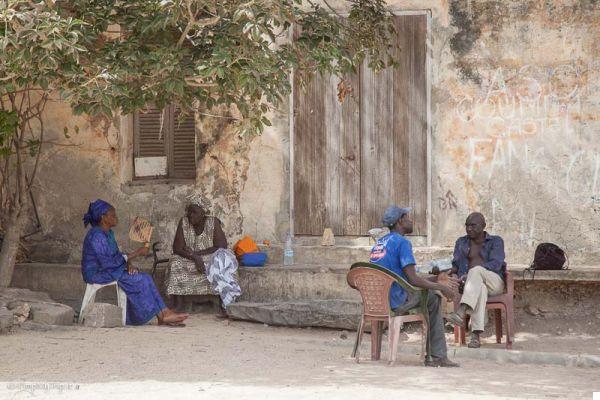
Scenes of everyday life on the island
They were mainly the Portuguese to start this trade, but the seventeenth century also saw the involvement of the Netherlands Britain (with slave ships departing from the ports of Liverpool, Bristol and London), the France (the busiest port was Nantes, followed by the ports of Bordeaux, Le Havre and La Rochelle) and the Denmark who owned plantations in the Antilles.
Men, women and children were crammed into ships in an inhumane way: the more slaves they brought and sold, the more they earned.
The overseers undressed them, shaved them to zero so that they did not cover themselves with parasites, branded them on the shoulder, made them lie down on the ground and set them up, naked and chained, next to each other.
On the lower decks of the ships, in spaces between 80 and 120 centimeters high, even 600 slaves were crammed and wedged together.
During the navigation twice a week the slaves were dragged on deck and washed with buckets of water and forced to dance so that their muscles did not lose tone and could therefore be sold at a higher price.
Needless to say, mortality was at staggering levels: one in four people died of starvation or disease, scurvy and dysentery in the first place, or was killed in ruthless repression.
Riots were on the agenda and were repressed by the white slave laborers with unprecedented violence.
Lots of men and women they chose to die by jumping into the sea rather than accepting a life of slavery.
There is, however, a story that I was told precisely in Gorée about a single ship on which the slaves had won over their oppressors: they turned the sails and returned home.
As a reward for their courage they were released and lived free for the rest of their lives.
Apart from this isolated case, however, the story was by no means a happy ending: the slaves who did not die arrived in America where the markets where they were sold for the second time as beasts and they were sent to work on the plantations.
In those of sugar, the average life was 10 years.
Between the 300th and 10th centuries (i.e. for about XNUMX years), it is estimated that at least XNUMX million Africans were enslaved and deported to the Americas.
Although most of the slaves were taken from Central Africa, particularly the Democratic Republic of Congo, a large portion of slaves in the transatlantic trade were captured directly in the Senegambia region.
It was no coincidence that Gorée was chosen as a place of imprisonment for the slaves waiting to embark them.
Like the English, in fact, the French also preferred to use the islands as a "warehouse for human goods" as they gave greater security that the slaves could not escape.
At the same time, they were easier to defend against in the event of attacks by other slave traffickers or by groups of armed Africans.
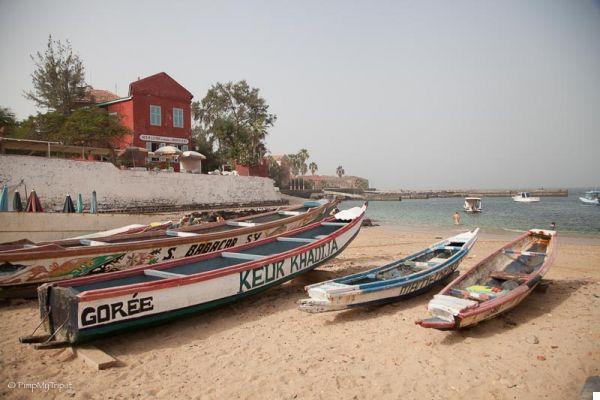
The quiet sandy beach was once the port where slave ships docked
Dozens of houses were built on the island of Gorée which served as temporary prisons for slaves before being sold to traders.
Some of these slaves remained on the island of Gorée: women were used as servants and servants of slave traffickers, men were used as pack animals to smash and transport stones used in construction or to load and unload ships.
Some "promoters" of tourism on the island say that from Gorée between 15 and 20 million slaves passed. Historical research, however, tells us that there were about 26.000.
Some historians have tried to downplay Gorée's importance in human trafficking, noting that it was nothing compared to other trading sites in other parts of Senegal (St. Louis and the region of Casamance), the Gambia and other West African countries.
Visit to the island of Gorée: what to see
House of Slaves (Maison des Esclaves)

The shell stairs of the House of Slaves. At the bottom, the Door of No Return
The island of Gorée is a zigzag of narrow, cobbled streets that develop between brightly colored colonial houses covered with bougainvillea that once belonged to wealthy slave traders.
Near the eastern coast, a small road passes by a large wooden door that opens onto the courtyard of the Maison des Esclaves (House of the Slaves).
Built as the home of a wealthy merchant in the late 1700s, the structure consists of two floors: the lower one, where there were the cells for the slaves and the upper one that served as a dwelling for the owner.
Downstairs the cells are divided into cells for men, women and children. In the smaller cells (real holes) under the inclined stairs those who had tried to rebel were locked up as punishment.
Once in Gorée gli slaves were classified by age, gender and tribal group and were branded with the trademark of the trading company.
The first thing that was done was to separate families and take away their names from people to take away their identity first of all.
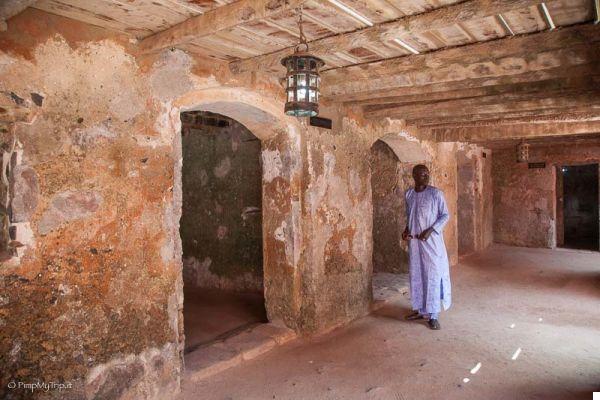
The cells of the House of Slaves where people were once locked up to be sold
Held in chains, the men sat with their backs against the cell walls, but sometimes so many were crammed inside that they found it hard to sit or lie down.
A narrow vertical opening it provided light and ventilation.
Outside in the open courtyard, shoppers viewed the prisoners as animals for sale, set their price, and completed the deal.
Il price of slaves it depended on their fitness and workforce.
Those too fragile could not survive the long journey by ship so they were locked up in a different cell to gain weight and thus become "salable".
A sinister feature of the Maison des Esclaves is its central corridor leading to the Door of No Return (Door of No Return): a door open directly on the waters of the Ocean.
Visitors are told that slaves passed through this gate to be loaded onto ships, although the true purpose of the gate and the entire structure has been much discussed by historians: the Gates of No Return existed and still exist in other historical sites than this. type.
La Door of No Return of the House of Slaves it has probably never been used for this purpose as the waters outside it were too shallow for a ship to dock.
Even today the debate on the Door of No Return of the House of Slaves is open.
In fact, many historians even doubt that the entire house was used to incarcerate slaves: it was in fact built quite late when trade was already in sharp decline. Probably only the house slaves of the owner who lived there lived here.
The second floor, which is accessed via two clamshell staircases, now exhibits panels that tell the story of the house and the slave trade. Iron shackles and other tools with which the dodgers were chained are also exhibited here.
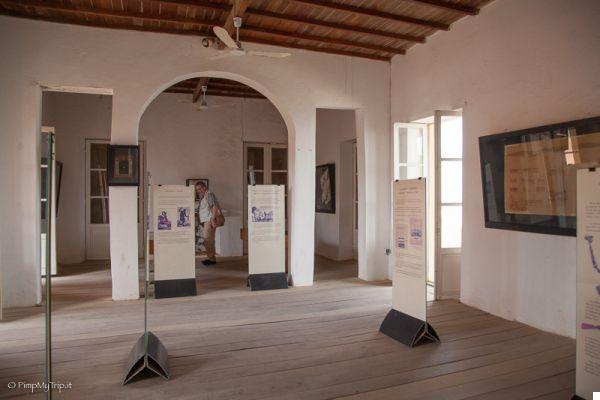
On the second floor of the House of Slaves, where the owners once lived, today a small exhibition on the history of the Maison has been set up
Despite the questions raised about the myth of the Maison des Esclaves, it certainly has enormous value as a place of remembrance; the building is primarily promoted as an emotional sanctuary to slavery, and UNESCO has classified it as an important historical site.
Despite the historical controversy, the House of Slaves is a testament to one of the darkest periods in history and has enormous importance, to the point of being visited by luminaries and heads of state such as Nenson Mandela and recently from Barak Obama.
Cost of entry: 600CFA
Hours: the House of Slaves is closed from 12:00 to 14:30
IFAN Historical Museum
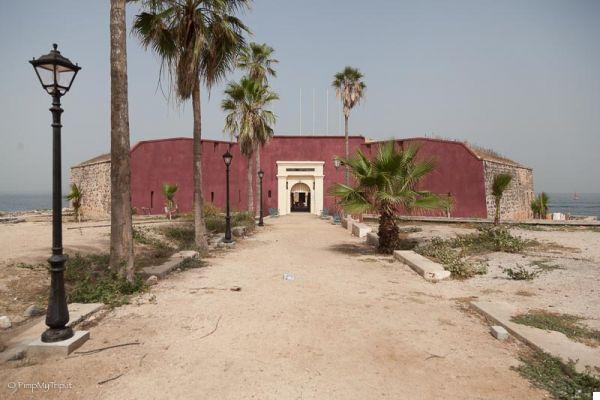
The entrance to the Fort d'Estrées, which today houses the IFAN Historical Museum
Il Fort d'Estrées where today the IFAN Historical Museum (Institut Fondamental d'Afrique Noire) was built during the XNUMXth century to protect the island of Gorée and the port of Dakar.
The cannons on the roof are reminiscent of its defensive role: the fort played an active role in 1940 when free British and French forces unsuccessfully attempted to take Dakar lest it be used as a German base.
The fort became a civilian prison from 1950 until 1977 when it was assigned to the Ministry of Higher Education for use by the IFAN as a museum.
The Historical Museum not only tells about the slave trade of the island of Gorée but traces the history of the island and of Africa from the beginning of time.
Inside there are ancient artifacts such as jewels, various tools and some skeletons that are dated to about a few million years ago.
One of the most famous "pieces" is a model of the Aurora a French ship from the port of La Rochelle, built in 1784 by the engineer Penevert e used for the slave trade.
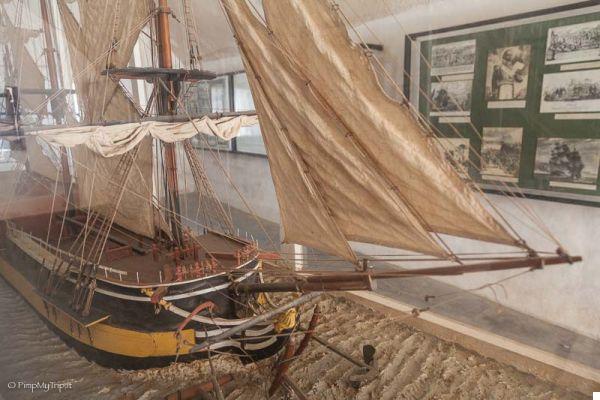
Model of the Aurora, a French slave ship. The explanatory panels on the sides "tell" about life on board and the slave trade
The Aurora had a crew of 40 and carried up to 600 slaves. Explanatory panels tell how the slaves were stuck on top of each other on the ship and the conditions of life on board. This is the part that I found most interesting about the whole museum.
Castle and cannon
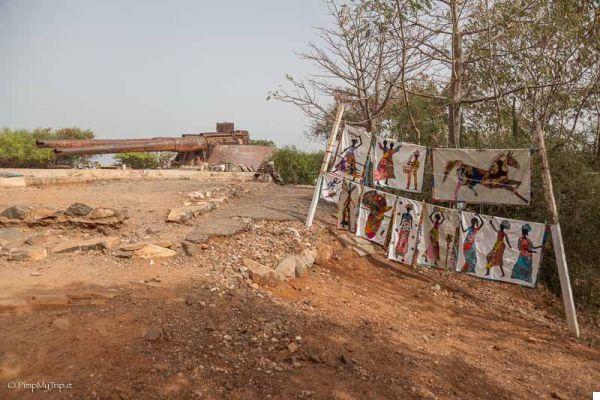
The cannon that fired only once at the top of the Castel di Gorée
On the south side of the island, a beautiful uphill avenue, flanked by centenarian baobabs, leads the Castle to its highest point. Near this place were the first Portuguese to build some structures and later the Dutch built the fortification called the castle, later renamed Forte St. Michele during the French occupation.
Although most of the fort was destroyed by the French before Senegal's independence, some concrete bunkers and a Cannon which appears to have fired only once to sink a British merchant ship in 1940.
There is not much else to see here apart from the cannon and a few souvenir stalls but the view from above over the sea and Dakar is worth the effort to get to the top.
Other things to see in Gorée
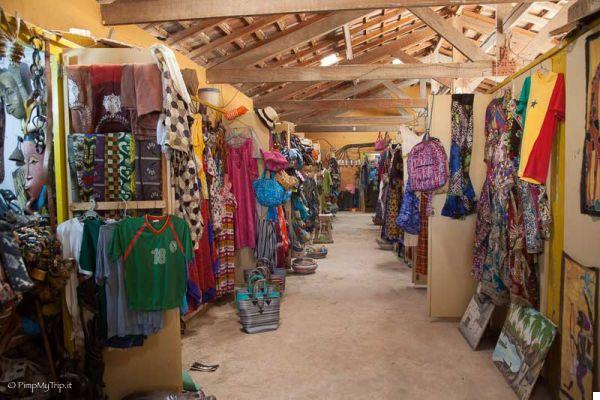
The handicraft market in which there are many souvenirs
Although the 3 main things are listed above, there are other things to see in Gorée:
- Mosque
- Woman's Museum
- Museum of the Sea
- Governor's Palace
- Chiesa Saint-Charles Borromeo
- Handicraft market
How to get to the island of Gorée
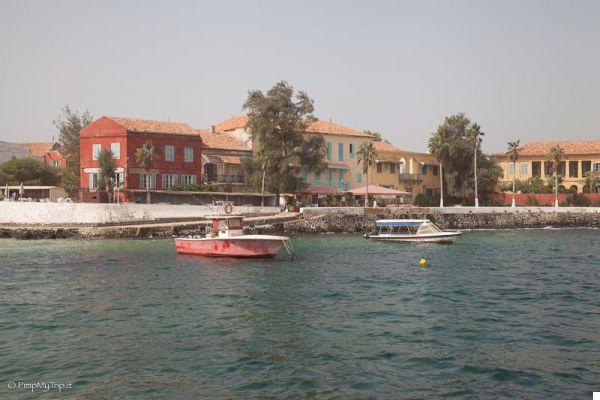
Arriving by ferry offers beautiful views of the island
Gorée Island can be reached from Dakar by ferry and it is easy to get there even on your own.
Il Ferry trip costs 5200 CFA per person for round trip and takes about 20 minutes to get to the island.
As soon as you get on the ferry you will be approached by the numerous souvenir vendors who work on the island, and after a while they will irretrievably invite you to visit them at their market stall.
Once in Gorée you have to pay one small fee of 500CFA which is used for the maintenance of structures, houses and buildings.
As an alternative to doing everything independently, you can rely on an agency: in case you don't speak French this is the best option as with the agency you will have a guide who will explain the interesting history of the island.
TOUR IN ENGLISH OF THE ISLAND OF GOREE
State offre this tour in English with hotel pickup (in Dakar), transport by ferry and guide.
However, the island is very easy to visit even independently.





